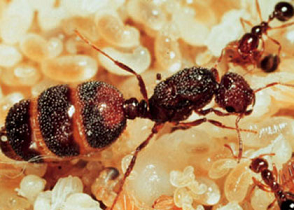The Ant Hierarchy: Super Organisms
Super Insects!
With the exception of termites, bees and wasps, most of the insects we are familiar with are solitary creatures. However, ants are considered “super-organisms”, or eusocial (the most social organisms), because they do not work for personal benefit but to benefit the colony as a whole. Using pheromones and body movement in order to communicate, ants live and thrive together as one! In the wild, the lone ant has a very slim chance of survival. For this reason, and its overall dependance on the hierarchical relationships, the ant is seen as an extension of the colony rather than its own organism. Read more to find out about the social hierarchy and life of the largest community below us!
The Beginning Stages
 To understand the social placement of the ant you must first delve into the life cycle. There are four developmental stages: egg, larva, pupa and adult. The purpose of the ant is determined during the larval state, as this is the crucial period of growth. The first determining factor for placement among the colony is the sex of the ant. If male, the ant will serve one purpose only: to mate. In fact, the lifespan of a male ant is only the duration of the mating season, as after that they are useless! If the ant is female, the amount of nourishment she is provided with will decide if she has what it takes to be a queen. The female larvae that receive the best amount of care and food will eventually grow wings and become sexually mature. These ants are considered “queens”, whereas the females who did not receive the same care will develop into workers or soldiers.
To understand the social placement of the ant you must first delve into the life cycle. There are four developmental stages: egg, larva, pupa and adult. The purpose of the ant is determined during the larval state, as this is the crucial period of growth. The first determining factor for placement among the colony is the sex of the ant. If male, the ant will serve one purpose only: to mate. In fact, the lifespan of a male ant is only the duration of the mating season, as after that they are useless! If the ant is female, the amount of nourishment she is provided with will decide if she has what it takes to be a queen. The female larvae that receive the best amount of care and food will eventually grow wings and become sexually mature. These ants are considered “queens”, whereas the females who did not receive the same care will develop into workers or soldiers.
The Working Class
The workers and soldiers can come in various sizes depending on the specific duty they will undertake. If a soldier, the ant will grow substantially larger. Not only will their body become larger, the soldiers develop substantially bigger heads that support their much larger, stronger mandibles. The job of the soldier ant is fending off various predators, such as spiders or flies, that will disrupt the nest. If not a soldier, the worker ant can take on various jobs such as scavenging for supplies, building the nest, taking care of the young, or they can be assigned to feed the queen and dispose of her waste. Because workers are vital in taking care of and building the nest, they are the type of ant produced the majority of the time. No matter what job is assigned, each ant plays a vital role in maintaining or building the colony.
The Queen
 Ironically, the queen has no power or control over the other ants. In fact, the true decision makers are the care takers of the queen and the soon-to-be queens, as they are the providers of nourishment. Because of this, paired with the amount of resources, the colony can have just one queen or multiple queens. The queen is a sexually matured, winged adult female that is capable of reproduction. However, as shown in the picture, queen ants will lose their wings after the mating ritual (which takes place in flight), and have found a suitable place for a nest. Her sole purpose is to mate, find a good place to nest and lay as many eggs as possible. The queen ant only needs to mate once and she can continuously give birth throughout her life. Astonishingly, the queen has the ability to determine what the sex of the ant will be. The majority of ants will be female workers and soldiers, as males are only produced when necessary for mating. Bigger than the males and soldiers, queen ants are by far the largest in the colony, reaching sizes multiple times that of the workers. Although most worker and soldier ants are lucky to survive longer than a year, queen ants have been known to live anywhere from 5 to 30 years! As if that’s not scary enough, queen ants have also been known to carry as many as 60,000 eggs in their abdomen at one time! With the care and protection of the ants in their community, queens can flourish and ant colonies will grow exponentially. Like humans, the fate of the community resides in the strength of the group as a whole, turning ordinary insects into “super-organisms”!
Ironically, the queen has no power or control over the other ants. In fact, the true decision makers are the care takers of the queen and the soon-to-be queens, as they are the providers of nourishment. Because of this, paired with the amount of resources, the colony can have just one queen or multiple queens. The queen is a sexually matured, winged adult female that is capable of reproduction. However, as shown in the picture, queen ants will lose their wings after the mating ritual (which takes place in flight), and have found a suitable place for a nest. Her sole purpose is to mate, find a good place to nest and lay as many eggs as possible. The queen ant only needs to mate once and she can continuously give birth throughout her life. Astonishingly, the queen has the ability to determine what the sex of the ant will be. The majority of ants will be female workers and soldiers, as males are only produced when necessary for mating. Bigger than the males and soldiers, queen ants are by far the largest in the colony, reaching sizes multiple times that of the workers. Although most worker and soldier ants are lucky to survive longer than a year, queen ants have been known to live anywhere from 5 to 30 years! As if that’s not scary enough, queen ants have also been known to carry as many as 60,000 eggs in their abdomen at one time! With the care and protection of the ants in their community, queens can flourish and ant colonies will grow exponentially. Like humans, the fate of the community resides in the strength of the group as a whole, turning ordinary insects into “super-organisms”!


































































